 |
 |
| It's not the longest railroad in the Portland area, nor does it have the largest fleet of rolling stock. But the narrow-gauge Washington Park & Zoo Railway is certainly the most distinctive. | 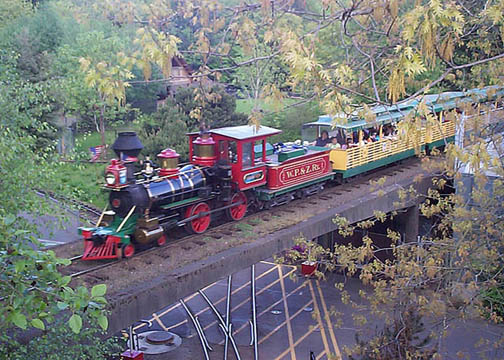 |
|
Here, Spring foliage frames the flagship of the WP&Z locomotive fleet, 4-4-0 #1 Oregon, as it crosses the overpass on the original zoo loop May 5, 2001. The oil-burning steam locomotive is a replica of the famous 4-4-0 Reno of Nevada's Virginia & Truckee Railroad. |
|
The Washington Park & Zoo is more than your typical amusement park rail line. It has history and fame that exceeds that of many full-scale railroads. Few of them can boast of still operating both steam and diesel locomotives, nor can they claim that they still carry the U.S. Mail. But the WP&Z does, and has done so for much of its history. This diminutive railroad carries on with a heart as large as those of the Oregon Zoo's elephants, whose house its trains pass on every trip. And those trains are as showy as the brightly-colored peacocks that roam the zoo grounds. |
 |
This train schedule board at the Washington Park station shows the trains running on July 19, 2003. It includes the times between arrivals, the average running times for the round trip between the park and the zoo, and last scheduled arrival of the day. |
It looks just like the schedule board you might find at any railroad depot. But how many of them let you know that en route, you can watch musk oxen, elk or elephants, or promise you lions and tigers and bears, oh my? |
|
The history of the WP&Z dates back to the early 1950s, when the Portland Zoo Commission decided to relocate and expand the zoo's grounds in Washington Park. The zoo had outgrown its existing grounds near the site of the present-day Washington Park station. The commissioners envisioned a train as part of the new attractions. The original plan was to construct a child-sized train with a track gauge of between 12 and 18 inches. But this apparently did not set well with several of the commissioners, including John Gilliard, who in 1952, during the planning for the new site, said "A kiddie's train is beneath the dignity of the Portland Zoo." |
| WP&Z #2, the Zooliner, heads onto the wye into the original zoo train loop May 5, 2001. The sleek streamliner had just climbed the three percent grade from Washington Park station on its return trip to the zoo. | 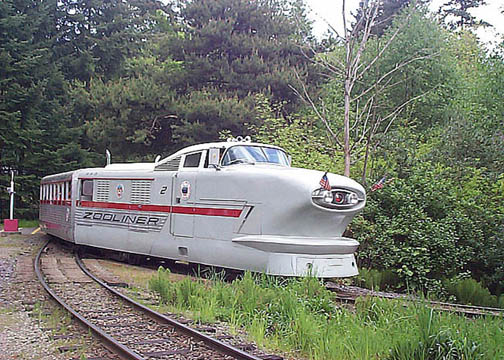 |
|
The train set is one of the zoo's original consists, dating back to 1958. It is modeled after the mid-1950s-vintage Aerotrain built by General Motors, and reflects the automobile-like styling GM incorporated into the full-sized original (The cars on the Aerotrain, for example, were actually copies of its then-standard 40-foot municipal bus body). |
|
The commission eventually settled on a track gauge of 30 inches between the rails. While this was still much narrower than the four feet, eight and one-half inch standard gauge found on American railroads, it still set the zoo railway apart from other amusement park-style trains. And its eventual construction and operation even drew the willing participation of the full-scale railroads that operated into Portland. The construction of the zoo railway proceeded alongside that of the zoo itself. The original one and one-quarter mile loop around the zoo grounds was the product of hundreds of hours of work, many of it volunteer effort, by railroaders whose companies operated into Portland. These included the Spokane, Portland & Seattle, the Southern Pacific and the Union Pacific. One particular day -- May 10, 1958 -- became known as "Gandy Dancer Day", after the term applied to railroad construction crews. Many of the railroaders' wives also showed up to serve refreshments for the laboring track crews. |
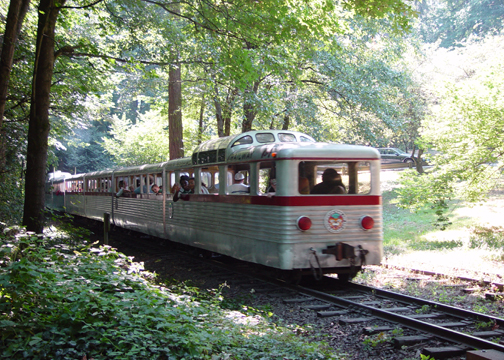 |
The Skydomer Club is the tail car on the Zooliner, shown here at Siding #3 Aug. 16, 2008. The car, as do the others in the consist, got its name from the dome-like skylights in the car's roof. The cars on the train also carry names of some of the famed Asian elephants that have lived at the zoo throughout its history. |
|
A ramp on the platform side of the car allows the train to board wheelchair-bound riders. The accessibility features on the train, as well as on the other WP&Z consists, were donated by local organizations. The train is now also a "domeliner", with this roof extension added over the wheelchair area. |
|
Meanwhile, as the right-of-way took shape, so did the trains. The H. Hirshberger Co. and Northwest Marine Ironworks constructed the railway's signature rolling stock -- the Steam Train, the Zooliner and the Circus Train. The trains of the Portland Zoo Railway, as it was originally known, actually debuted in two separate locations. The Steam Train and the Zooliner were among the featured attractions at the 1959 Oregon Centennial Exposition. The Circus Train began regular operations on the original zoo loop in Washington Park. The Centennial Exposition, which celebrated Oregon's first 100 years of statehood, was held on the grounds of what is today the Portland Expo Center near the Columbia River. The entire rail operation, which included the trains, track, signals, buildings and other infrastructure, eventually found its way to the West Hills, much of it going into the 1960 Washington Park extension. |
| WP&Z diesel #5 leads a mixed consist into the Washington Park station on July 19, 2003. The locomotive itself dates back to the original 1958 rail operation, and was originally a "steam" locomotive on the line's Circus Train. It was extensively rebuilt over the years, and eventually became the Oregon Express. | 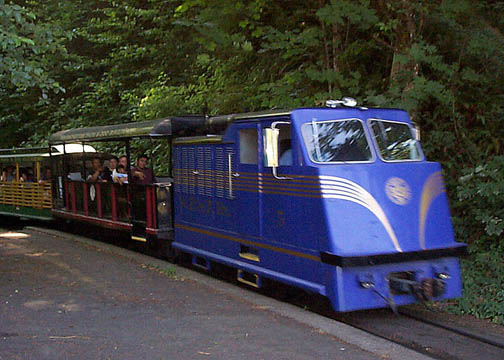 |
|
This train was carrying rolling stock from two of the line's trains. The locomotive and the lead car were both from the Oregon Express, while the last four cars normally ran as part of the Steam Train behind WP&Z 4-4-0 #1, which was being rebuilt at the time. The diesel wore its most recent color scheme of medium blue, with gold striping similar to that found on locomotives of the old Pennsylvania Railroad. The lead car wore the old Oregon Express colors of black with red striping, while the trailing cars were all in the Steam Train colors of green and gold. |
|
The Portland Zoo Railway expanded beyond its original loop in 1960, when construction crews laid a two-mile extension from the zoo downhill to a site next to the park's famous Rose Gardens and Japanese Gardens. Again, Portland's other railroads came to lend a hand. Crews from the Southern Pacific and the Spokane, Portland & Seattle laid down the track, while Union Pacific crews hauled the ballast for the roadbed. |
 |
The Washington Park station between trains on July 19, 2003. It occupies a hill overlooking the Rose Gardens, and provides some significant views of the Portland city skyline and the nearby Cascades, including snow-capped Mount Hood, Mount Saint Helens and Mount Rainier. |
|
The building originally served as the main station for the rail operations at the Oregon Centennial Exposition in 1959 before its reconstruction as the Washington Park stop for WP&Z trains. Trains loop around the station from right to left, and usually stop for about five minutes. Multiple train operations allow passengers to disembark here and visit the gardens, then reboard a later train back to the zoo, or board here, spend time at the zoo, then return. |
|
The right-of-way follows a three percent grade from the gardens area up to the zoo, a fairly steep climb for any railroad. The route includes many twists and turns, including a horseshoe curve, and also utilizes short passing sidings to allow several trains to use the line at the same time. One of these, Siding #3, is visible from Kingston Road, which also connects the zoo area with the gardens. Its location next to the park's Big Meadow is easily accessible and provides a good train watching and photo spot. |
| WP&Z 4-4-0 #1 Oregon leads the Steam Train out of the zoo grounds en route to Washington Park May 5, 2001. It is passing one of two grade crossings on the line. The crossing signals, which are similar to those on any highway-rail grade crossing, help protect zoo visitors walking to several exhibits north of the tracks. | 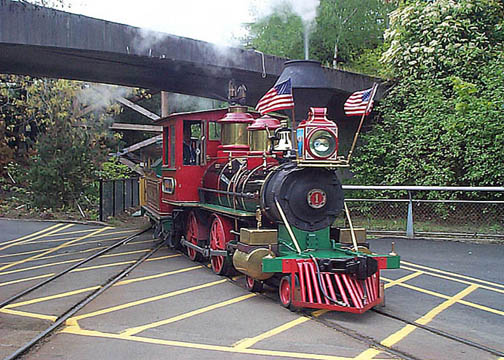 |
|
The track to the left leads to the original zoo loop built in 1958, while the track the train is using leads downhill to the 1960 extension. A wye (behind the photographer) connects the trackage. Trains on the zoo loop return to the station on the overpass above the crossing. |
The WP&Z holds another distinction, that of a U.S. Mail carrier. The railroad began carrying mail under contract June 13, 1961, a practice that actually continues today! The railroad has its own postal cancellation stamp, which it also uses on special events such as the railroad's anniversaries and birthdays of some of its special animals. It was one of the first recreational railroads to have its own postal cancellation, and today is the last one operating with its own cancellation to continuously offer mail service. |
 |
This is the mail box at Washington Park station. It is still possible today to mail a letter here and have it canceled at the zoo before it goes out. Locomotive #2 also carries a mail slot just behind the engineer's cab. |
|
The displays on the wall behind the mail box are part of a small museum room at the station that outlines the history of the WP&Z. |
|
The present-day WP&Z carries more than 300,000 riders a year. Service is provided by a mix of both professional staff and volunteers. Volunteers have helped the WP&Z throughout its history, just as volunteers are an integral part of other recreational railroads and museum operations through the U.S. Several WP&Z volunteers are also active railroaders. One of the more notable volunteer efforts occurred in 1960 when the railroad added its Washington Park extension. Children sold stock certificates to help fund the expansion. |
| Two of the railroad's newest car conversions catch the mid-afternoon sun as they trail the Steam Train past Siding #3 on its way to the Washington Park station Aug. 16, 2008. The cars sport a "jungle" theme, complete with thatched roofs. | 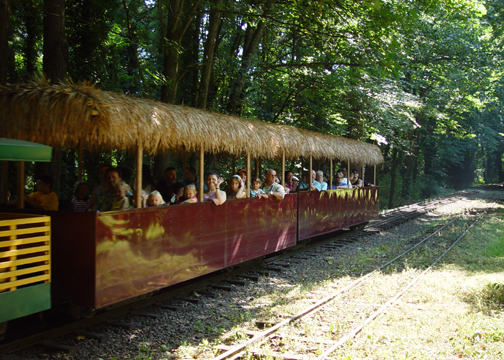 |
In addition to its regular trains, the WP&Z also has two other locomotives, primarily for use in work train service. Diesel #3 closely resembles an EMD switcher, while diesel #6 looks more like an industrial locomotive. The WP&Z locomotives and cars wear the road's distinctive logo, a stylized tiger in an engineer's cap. |
|
In the Spring and the Fall, WP&Z trains normally operate only on the inner loop at the zoo. Rail operations to and from the Washington Park station run during the summer. In addition to its normal operations, the WP&Z also provided other unique events during the year. ZooBoo, in late October, turned the zoo rail loop into a rolling "haunted house", incorporating scary scenery both on board and along the route with zoo staff and volunteers all decked out in costume. During the Christmas season, the annual Zoo Lights brings a touch of holiday spirit to the railway, combining brightly-lit trains with other festive touches. |
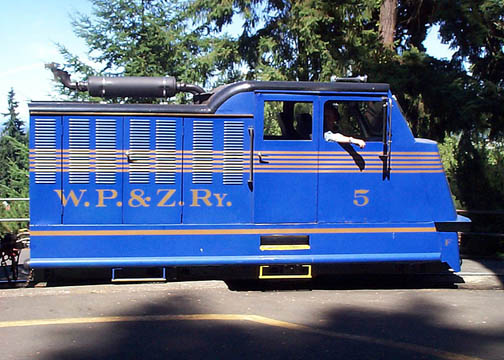 |
Diesel #5 shows off its lines while waiting for a highball at Washington Park station July 19, 2003. All of the WP&Z diesels employ a hydraulic drive instead of the diesel-electric drive found on most-full-sized diesel locomotives. |
The best way to railfan the WP&Z is to visit the zoo. Passengers boarding the trains at Washington Park purchase a ticket that is both train fare and zoo admission, while those boarding at the zoo purchase their tickets at the rail station after entering the zoo. Passengers riding from the zoo to the gardens who choose to disembark and return on a later train simply receive a hand stamp from the ticketmaster at the depot. There are several excellent photo locations on the zoo grounds. These include the depot with its adjacent water plug, the pedestrian overpass above the tracks near the main entrance, which overlooks the rail overpass and the wye, and the rail crossings adjacent to the wye and the overpass. The original loop was extensively rebuilt in 2013 and 2014 as part of the construction of a new elephant house at the south end of the zoo grounds. The railroad was shut down during this time, but reopened in time for the 2014 Zoo Lights. The Washington Park extension remained closed after the original loop reopened. Efforts to rehabilitate the line have stalled in recent years. There is currently a call to have the railroad designated as a National Historic Landmark, which would allow for federal funding of its rebuilding. The Oregon Rail Heritage Center in Portland has also dedicated some of the income from its summer-season train rides to the rebuilding and re-opening of the extension. |
| To navigate through the site, just click on one of the links in our image map. | |
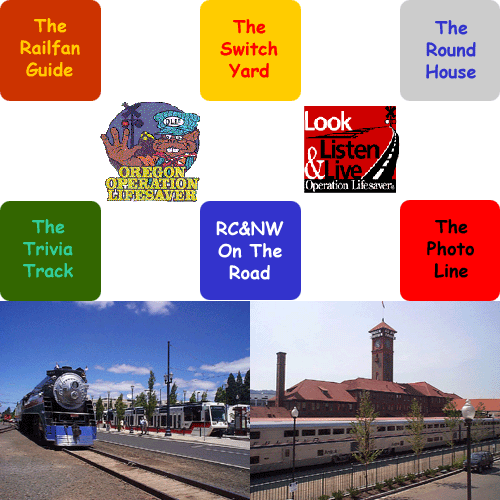 |